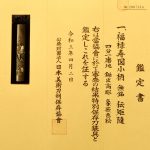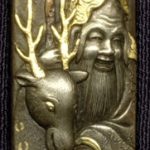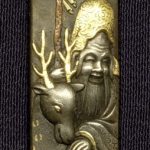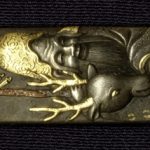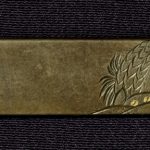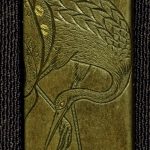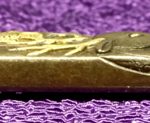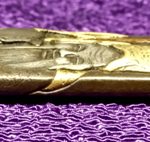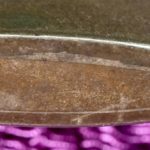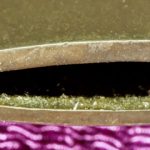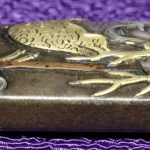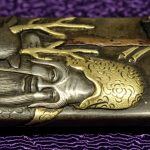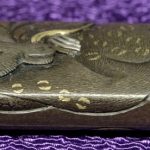HAMANO NORIYUKI / NBTHK HOZON
HAMANO NORIYUKI
Hamano Noriyuki (浜野矩随) represents two generations with very similar work styles. The first generation is not so much seen and was a student of Hamano Shozui. His personal name was Someno Chugoro and he was born in 1736 and died in 1787 at 52 years old. He is said to have taken on the craftsman name Noriyuki very early, somewhere around 16 years old. The second generation is his son, and was known as Matsujiro, and born in 1771. He began working at the age of 14 and was only 15 years old when his father died and his mother is supposed to have committed suicide before this.
The second generation is said to have trained under Shozui as well in 1784. Probably this is not the school founder as at that time the first Shozui had died. At age 17 his first signature was Masakata (政方), obtaining the Masa character from Shozui, and after the death of his father he studied under his father’s student Asama Nagayuki and at this point he changed his name to Norinobu (矩施). He became independent at age 23 he took over his father’s name Noriyuki two years later. He used several different Go, one of which is Shojuken (松寿軒) which is a humorous poke at his own longevity. As far as I can tell, the characters loosely mean as old as a pine tree.
The style of the two Noriyuki shows much influence from Nara Toshinaga, who was the teacher of the first generation Shozui, along with influence from Sugiura Joi. This gave Noriyuki a unique and identifiable style among the Hamano smiths. The second generation is said to have tended more to the Hamano style, however he is also noted as being highly influenced by Joi.
The main line of the Hamano school descends from Shozui, to Kaneyuki (2nd) who was a peer to the first Noriyuki. From here it goes to Nobuyuki (3rd), Masanobu (4th), Masayoshi (5th) and then shifts over to the second generation Noriyuki. Noriyuki prospered greatly and had many excellent students. He died at 82 years old in 1852.
Both generations of Noriyuki have been targeted by forgers and we can take this to mean that they have been held in high regard for a long time. This is seen in the Kinko Meikan as the first generation is ranked Meiko (second to highest possible) and the second generation Ryoko (third to highest). In spite of their fame and high level of skill, work of either smith is rather difficult to find today.
HAMANO SCHOOL HISTORY:
Hamano Shozui (政随, which can be read as Masayuki) was born in 1696 and died in 1769. He is an elite maker of sword fittings and ranked very highly at Meiko in the Kinko Taikan. He is the founder of the Hamano school.
Hamano Shōzui (浜野政隋) was a master student of Nara Toshinaga (奈良利寿). His first name was Tarōbei (太郎兵 衛) and he trained many students himself, turning the Hamano School into one of the major currents of the machibori trend. Shōzui used many different gō, for example Otsuryūken (⼄柳軒), Miboku (味墨), Kankei (閑径), Rifūdō (驪⾵ 堂), Yūkotei (遊壷亭), Shūhōsai (穐峰斎), Hankeishi (半圭⼦), and Isshun’an (⼀瞬庵). Shōzui became very famous when the Edo Kinkō Meifu (江⼾⾦⼯名譜) introduced him as “hitting the scene like thunder” and turning the Nara Sansaku (奈良三作), the “Three Great Nara Masters,” by adding Shōzui to the Nara Shitennō (奈良四天王), “The Nara Big Four.” His talent was and is greatly appreciated and he was exceptionally skillful in bold takanikubori, sukidashibori, shishiaibori, and katakiriboro.
-NBTHK Juyo Nado Zufu
Shozui began his artistic period in the Nara school, as a student under one of the Nara Sansaku (three great gold-workers of Nara), Nara Toshinaga and would go on to found the Hamano school. Due to his greatness this set of three masters (Toshinaga, Yasuchika and Joi) is sometimes extended to a quartet including Shozui.
Hamano Masayuki [i.e. Shozui] was Nara Toshinaga’s pupil, a famous master smith, and his works are considered to be at the same level as the Nara sansaku (the three best master smiths), Toshinaga, Joi and Yasuchika. His styles are diverse, and he inherited his teacher Toshinaga’s style and took the essence of Joi and Yasuchika’s work. His dynamic engraving styles, taka-nikubori, sukidashibori, and shishiaibori, show excellent skills.
-NBTHK Token Bijutsu.
The Hamano school thrived in the Edo period and produced a large number of works that relate both to its founding in Nara and to the contemporaneous Yokoya school. Other great artists of this school are Noriyuki, Naoyuki, Iawama Masatoshi, and Horie Okinari.
His school was very capable of keeping up with the Yokoya school in terms of number of students and influence on the machibori movement. Simply spoken, he combined the styles of the Yokoya and the Nara school with the interpretations of Sugiura Jōi, that means he worked in takabori-iroe and in zōgan but with larger-sized motifs than those use by the Nara school, enriched with usunikubori and shishiaibori. And regarding his selection of motifs, he chose various historical, epic, worldly and figurative subjects, as well as a broad variety of plants and animals. -Markus Sesko, Kinko Kodogu
(Used with permission by Darcy Brockbank).
Price: SOLD
If you are interested in owning this item, contact me directly at yakiba.com@gmail.com
